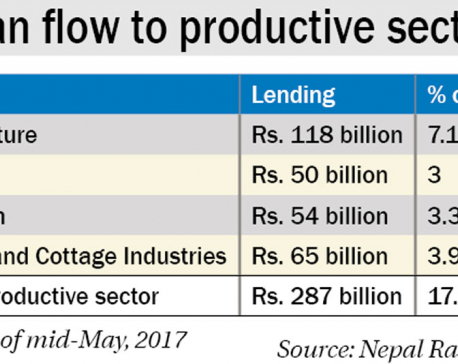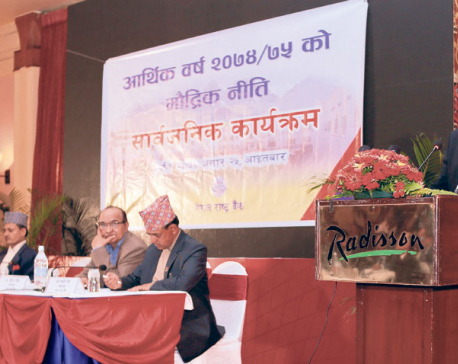
OR
3rd quarter review of monetary policy for fiscal year 2017/28
Commercial banks struggle to meet directed sector lending requirement
Published On: May 25, 2018 07:57 AM NPT By: Republica | @RepublicaNepal
KATHMANDU, May 25: Commercial banks are found to be struggling to meet the directed sector lending requirement set by the Nepal Rastrsa Bank (NRB).
While the NRB requires all commercial banks to float at least 25 percent of their total credit to priority sectors, they have managed to extend only 21.7 percent of their total credits to the productive sector as directed by the NRB as at third quarter of the current fiscal year.
According to the NRB data, 28 commercial banks have extended a combined Rs 435.16 billion, or 21.7 percent, of their total loans to the priority sectors as defined by the central bank. During the review period, total lending of these commercial banks stood at Rs 2,005.34 billion, the data shows.
Had these commercial banks met the directed sector lending requirement, these priority sectors would have received Rs 66.18 billion additional funds from the banking industry.
Banks have floated only 7.3 percent of their total loans to agriculture sector while credit flow to hydropower/energy and tourism sectors remained at 3.3 percent and 3.5 percent, repetitively. Other sectors like export-oriented industries, SMEs, cement and garment industries, received 7.6 percent of the total lending.
According to the central bank, the 25 percent directed lending requirement includes 10 percent credit in agriculture sector, 5 percent in hydropower/energy, 5 percent in tourism and remaining 5 percent in other sectors defined by the NRB as productive sectors.
By requiring banking institutions to provide certain percent of their credit in the priority sectors, the central bank wants to ensure that the productive sectors, which may not give instant return, also have financial resources at their disposal to boost domestic production. Such move of the central bank is also expected to help in reducing trade deficit and contribute to job creation and economic growth of the country in the long run.
According to NRB officials, the policy intervention of the central bank is also aimed at reducing the concentration of financial resources on certain sectors like trading, real estate, margin lending and other unproductive sectors.
The central bank has been gradually increasing the minimum lending requirement to the priority sectors. Through the Monetary Policy of the Current Fiscal Year 2017/18, the central bank has increased the productive sector lending by 5 percentage points to 25 percent of their total lending.
But it is becoming difficult for the commercial banks to meet the new requirement. Some banks have even paid penalty to the central bank in the previous years for their failure to meet the lending requirement. Many banking executives have even demanded that the central bank phase out such requirement stating that such regulation goes against the ‘free market’ theory.
However, NRB officials say that banks have the mid-July deadline to meet priority sector lending requirement. “The central bank will take action if any bank fails to meet the requirement by the end of the current fiscal year,” an executive director of the NRB told Republica.
POLICY UNCHANGED
Releasing the third-quarter review report of the Monetary Policy, the NRB has kept all its all rates and targets unchanged. However, the central bank projects that the inflation is likely to remain far below its target. Against the target of the central bank to contain annual inflation at 7 percent, the price rise is likely to be on the lower side. Average inflation in the three quarters of FY2017/18 remains at 4.1 percent, according to the NRB.
“The inflation seemed to remain lower than the target on accounts of increase in domestic production due to regular power supply, improvement in supplies and low inflation in India,” reads the review report of the monetary policy for the third quarter.
Meanwhile, the central bank has also said that the new monetary policy, which is expected to be unveiled next month, will be prepared by taking into consideration the priorities, policies and programs and budget size of the federal government as the expenditure is set to increase amid spending by the federal government, provinces and local units for rapid economic development.
You May Like This

Banks struggle to meet productive sector lending requirement
KATHMANDU, July 29: Commercial banks are struggling to meet the directed-sector lending requirement as set by Nepal Rastra Bank (NRB). Read More...

NRB raises productive sector lending requirement to 25%
KATHMANDU, July 10: Nepal Rastra Bank (NRB) has raised the lending requirement for commercial banks toward productive sectors by 5 percentage... Read More...

Banks told to make deprived sector lending in phase-wise manner
KATHMANDU, Aug 30: Nepal Rastra Bank (NRB) has instructed commercial banks to disburse at least two percent of their total... Read More...

Just In
- World Malaria Day: Foreign returnees more susceptible to the vector-borne disease
- MoEST seeks EC’s help in identifying teachers linked to political parties
- 70 community and national forests affected by fire in Parbat till Wednesday
- NEPSE loses 3.24 points, while daily turnover inclines to Rs 2.36 billion
- Pak Embassy awards scholarships to 180 Nepali students
- President Paudel approves mobilization of army personnel for by-elections security
- Bhajang and Ilam by-elections: 69 polling stations classified as ‘highly sensitive’
- Karnali CM Kandel secures vote of confidence


















Leave A Comment